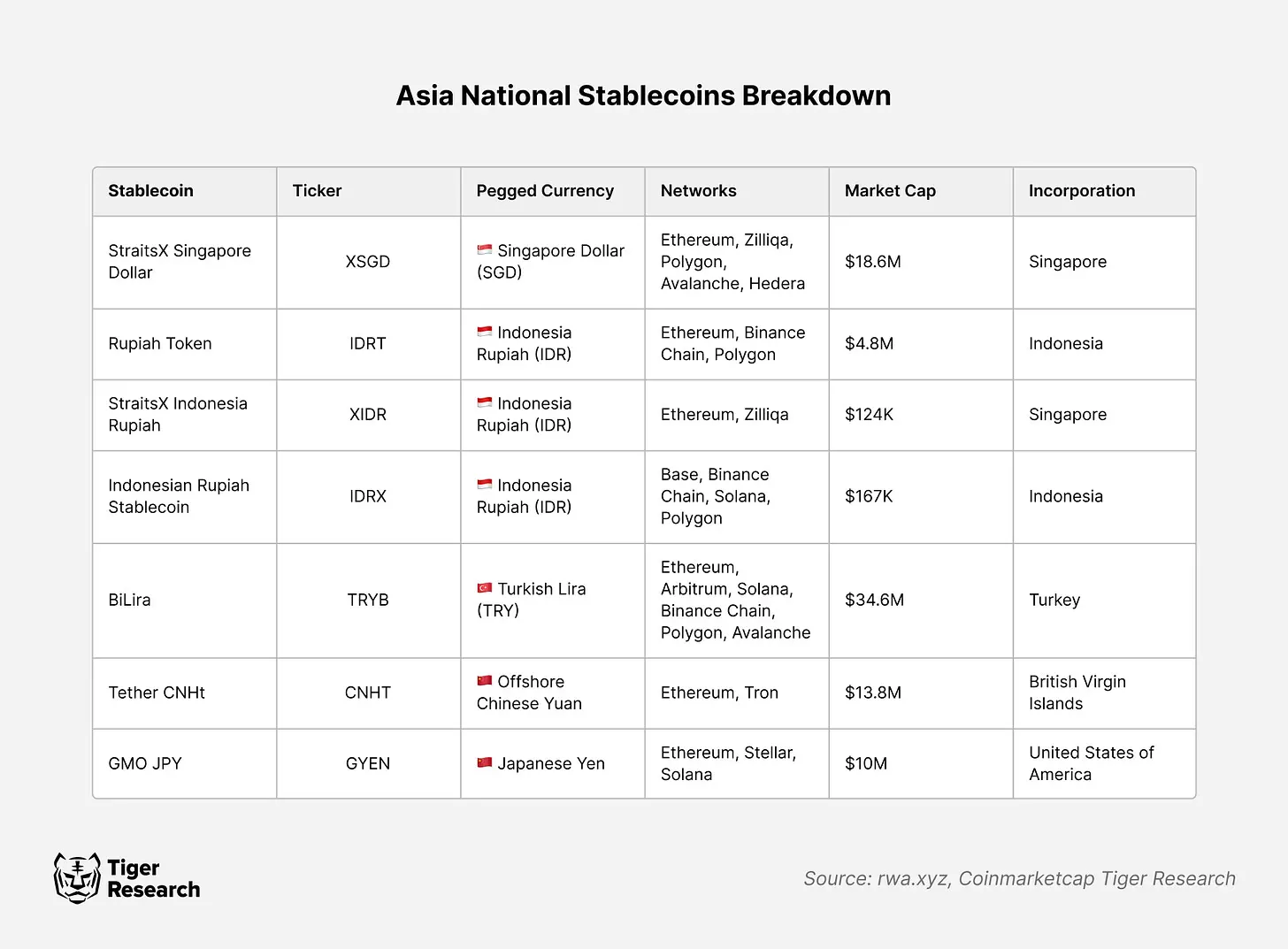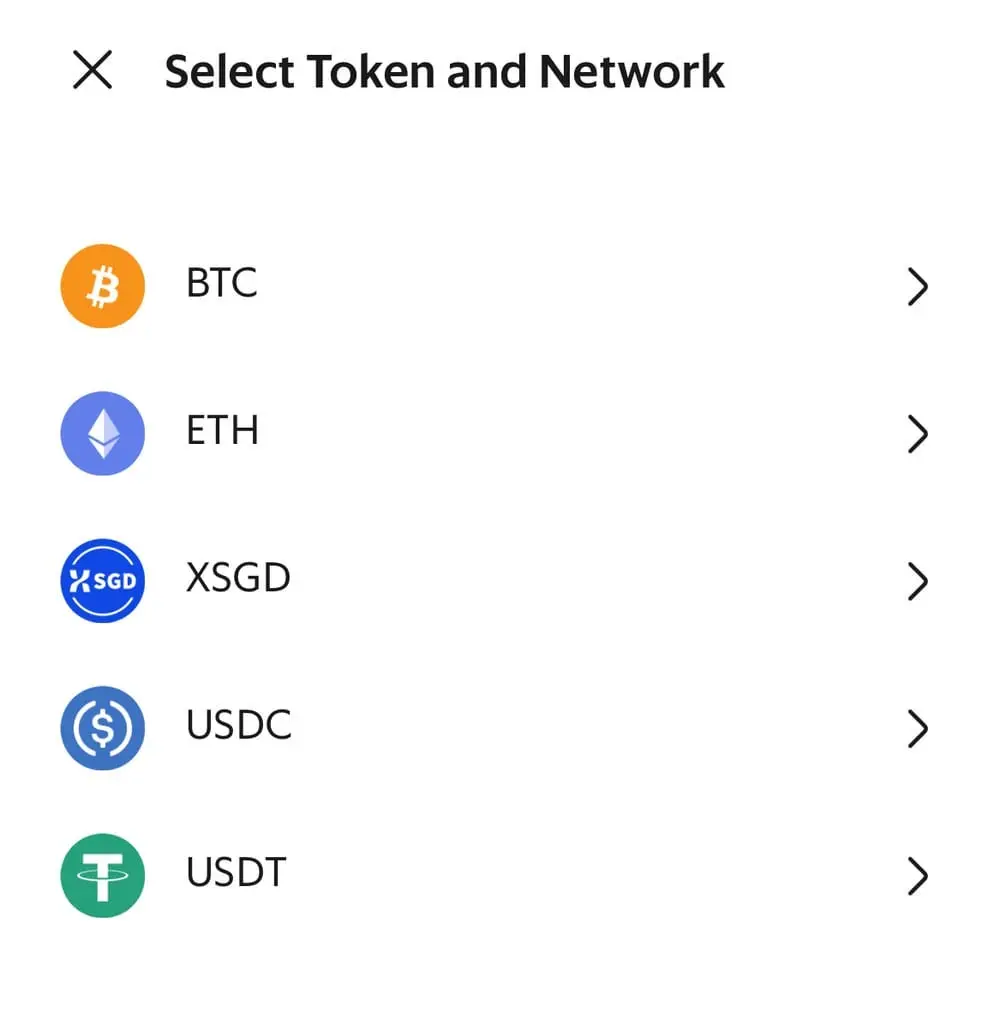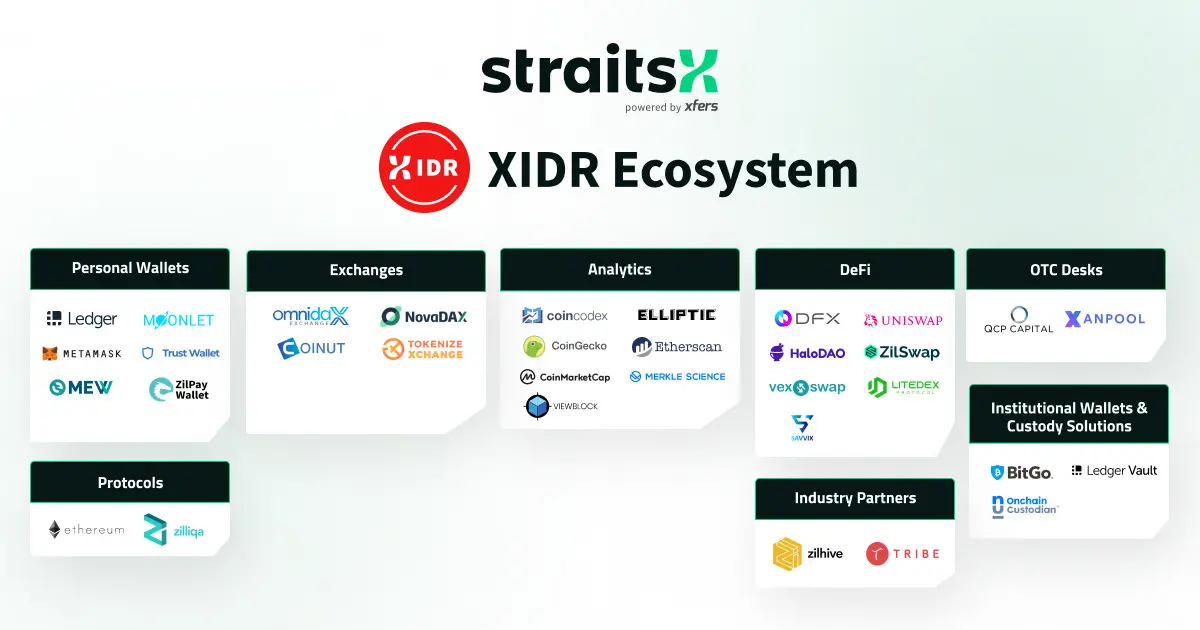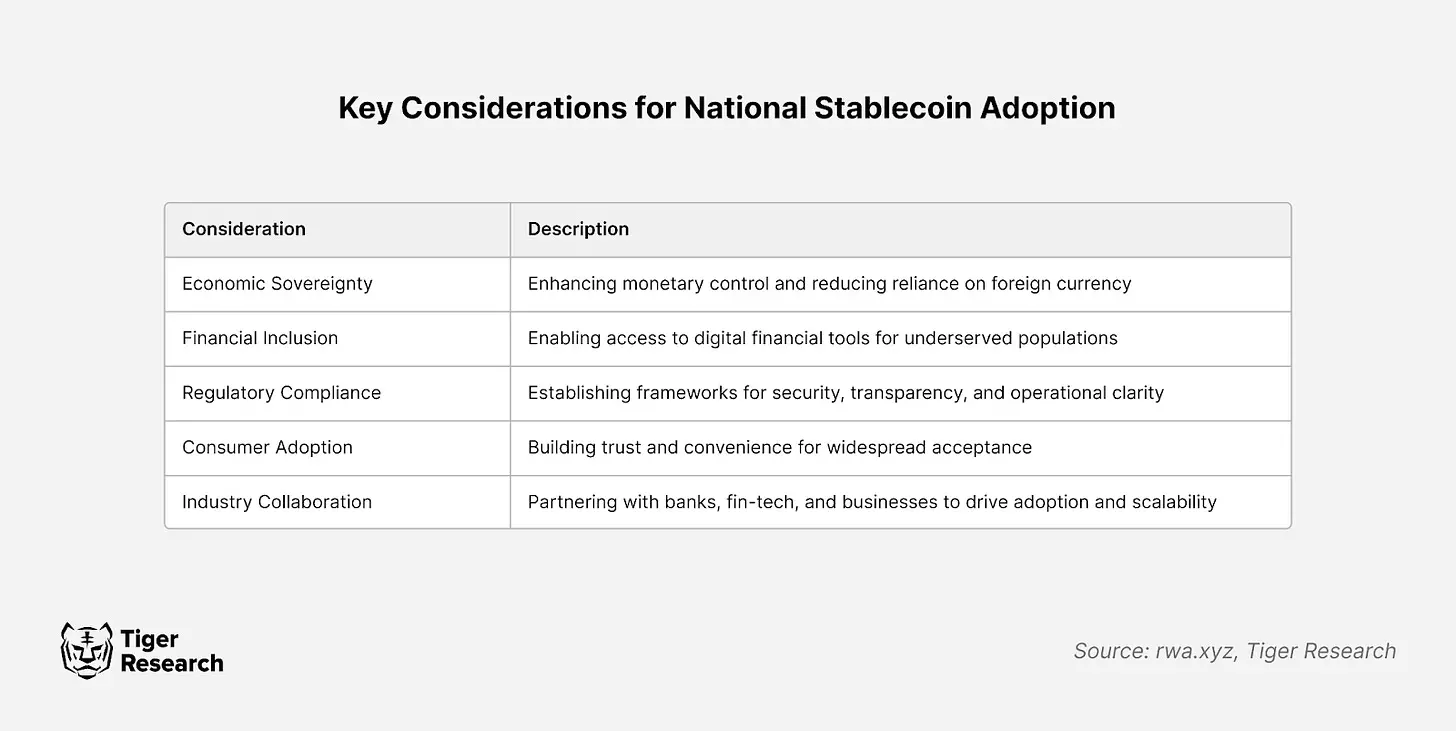National Stablecoins: Asia's Strategy to Reduce Dependence on the Dollar
Author: Chi Anh, Ryan Yoon, and Yoon Lee
1. The Dynamic Shift in Stablecoin Adoption
Currently, most stablecoins are pegged to the US dollar (USD), reinforcing the dollar's dominance in the global financial arena. However, Asia has begun to shift towards issuing stablecoins pegged to local currencies. This change aligns with broader global economic trends, as many countries seek to reduce their reliance on the dollar in trade, investment, and financial transactions.
The core question this report seeks to explore is: Despite the dollar's dominance, why do some Asian countries still issue non-dollar stablecoins? To answer this question, we will examine the benefits of national stablecoins, highlight key case studies, and explore how non-dollar stablecoins are playing an increasingly important role in the Asian financial landscape.
2. Benefits of National Stablecoins
The primary motivation for issuing national stablecoins is to maintain monetary sovereignty. By pegging stablecoins to their national currencies, countries can ensure that their monetary policies align with national economic goals. This allows for better control over economic and political outcomes. Countries can manage external economic pressures more effectively, which is particularly important during periods of volatility in the foreign exchange market.
Many Asian countries, especially those that have experienced currency crises, are particularly sensitive to these issues. This makes stablecoins an attractive tool for enhancing economic stability and resilience. However, most countries prioritize the development of central bank digital currencies (CBDCs) over stablecoins issued by private companies.
CBDCs provide governments with more direct control over monetary policy and the financial system, making them easier to regulate than private stablecoin alternatives. Currently, only a few countries allow the issuance of stablecoins. Most countries are still in the process of developing regulatory frameworks and considering implementation.
However, limiting the proliferation of dollar-pegged stablecoins like USDT and USDC poses a challenge. It is estimated that in South Korea, about 10% of trade is conducted through dollar stablecoins, and these transactions are often not recorded in official statistics. Recognizing these practical limitations, governments are accelerating efforts to formulate policies that help them compete effectively in the global stablecoin market.
3. Case Studies: Asian Non-Dollar Stablecoin Projects

3.1. StraitsX Singapore Dollar (XSGD)
XSGD is issued by StraitsX and is a stablecoin backed by the Singapore dollar, operating on Ethereum and expanding to four other networks. With a market capitalization of over $18 million, it has quickly become one of Asia's most trusted stablecoins due to its establishment under the Payment Services Act of the Monetary Authority of Singapore (MAS).

Users can top up using XSGD in the Grab App. Source: blockhead.co
XSGD enables seamless cross-border transactions in Singapore dollars, benefiting businesses and traders operating in Southeast Asia. In 2024, Singapore's super app Grab allowed users to top up their digital wallets using cryptocurrencies including XSGD, expanding its utility in everyday transactions. By using a stablecoin pegged to the Singapore dollar, companies can avoid converting to dollars, saving on exchange fees and speeding up transactions.
3.2. Indonesian Rupiah Token (IDRT)
IDRT is issued by PT Rupiah Token Indonesia and is a stablecoin pegged to the Indonesian Rupiah (IDR). With a market capitalization of over $4.8 million, it operates on networks such as Ethereum and Binance Smart Chain. Although the Indonesian government does not promote specific stablecoins, it has expressed support for blockchain technology as part of its broader goal to enhance financial inclusion and support the digital economy.

Source: rupiahtoken.com
IDRT is widely used across various CEX and DEX platforms, such as Binance, Uniswap, and PancakeSwap, allowing users to trade and invest using a currency pegged to the Indonesian Rupiah. This accessibility on popular exchanges expands IDRT's role in the decentralized finance (DeFi) ecosystem, making it a practical tool for users seeking exposure to the Indonesian currency in the cryptocurrency space.
3.3. StraitsX Indonesian Rupiah (XIDR)
 XIDR ecosystem. Source: StraitsX
XIDR ecosystem. Source: StraitsX
XIDR is also issued by Xfers and is pegged to the Indonesian Rupiah, forming part of the broader StraitsX ecosystem, which includes XSGD. Although XIDR has a relatively small market capitalization of $124,960, it shows growth potential, especially as Indonesia integrates blockchain solutions into its financial infrastructure.
Compared to IDRT, XIDR's ecosystem is broader, supporting multiple DeFi platforms, institutional custody solutions, and a wider range of personal wallet options, which may provide it with broader utility in areas such as decentralized finance and institutional trading. Despite XIDR's involvement in multiple sectors, its market capitalization is lower than that of IDRT, possibly due to IDRT's earlier establishment in the field. In the future, XIDR may play a key role in Southeast Asia's financial landscape, providing fast and efficient payment services for online retailers across the region.
3.4. Indonesian Rupiah Stablecoin (IDRX)
IDRX is developed by PT IDRX Indo Inovasi and is a stablecoin pegged to the Indonesian Rupiah, operating across multiple blockchain networks, including Base. Its primary goal is to connect traditional finance and Web3 by providing a stable digital representation of the Indonesian national currency.

Source: IDRX
Like other stablecoins, IDRX is committed to enabling decentralized finance applications, facilitating cross-border payments and remittances, and providing stability to hedge against cryptocurrency market volatility. Although still in its early stages, IDRX has already partnered with Indonesia's largest cryptocurrency exchange, Indodax. While it has yet to incorporate advanced features such as fair trading mechanisms, the project shows significant potential for widespread adoption and functional expansion, thereby strengthening its role in Indonesia's evolving digital economy.
3.5. BiLira Turkish Lira (TRYB)
BiLira (TRYB) is a stablecoin based in Turkey, pegged to the Turkish Lira, and is an Ethereum-based stablecoin that provides insights relevant to the Asian market. BiLira has a market capitalization of approximately $34.6 million, operates with less direct regulation, and carries higher risks, but fills the cross-border payment gap involving the Turkish Lira. Additionally, the developers of TRYB, BiLira, have launched their innovative cryptocurrency exchange BiLira Kripto , providing users with more channels to trade and transact using stablecoins supported by the Turkish Lira.
However, given the ongoing instability of the Turkish Lira against the dollar, currently, 4% of Turkey's GDP is used for purchasing stablecoins. This poses significant challenges for local stablecoins like BiLira in competing with dominant currencies like the dollar.
3.6. Tether CNHt (Renminbi)
Tether CNHt is pegged to the offshore Renminbi (CNY) and serves as a stablecoin for international trade by Chinese enterprises. Despite strict regulations on cryptocurrency activities in China, CNHt allows businesses to settle transactions in Renminbi without exposure to exchange rate fluctuations, providing a solution for traders wishing to transact in Renminbi.
However, it is noteworthy that Tether CNHt competes with the official Chinese digital Renminbi (also known as e-CNY), which has seen broader adoption in China. The digital Renminbi is heavily promoted by the Chinese government, integrated into the domestic financial system, and favored for retail and institutional trading due to its legal status and support from the People's Bank of China. Additionally, it has recently integrated with Huawei's HarmonyOS NEXT operating system, significantly enhancing its accessibility and further solidifying its position in China's digital financial ecosystem.
In contrast, Tether CNHt is positioned for offshore markets and international transactions, providing an alternative to dollar-pegged stablecoins. In domestic use, the digital Renminbi is increasingly utilized for everyday transactions, such as in Beijing and Shanghai retail payments. This widespread promotion makes it more popular in mainland China compared to private stablecoin alternatives like CNHt.
3.7. GMO Yen (GYEN)
GMO JPY (GYEN) is a stablecoin issued by the regulated entity GMO Trust based in the United States. GYEN is pegged to the Japanese Yen (JPY), operates on Ethereum, and has a market capitalization of $10 million. Unlike other stablecoins primarily targeting retail or emerging markets, GYEN aims to serve institutional clients, providing a safer and more regulated alternative for businesses trading in Yen. Bitstamp was one of the first CEXs to accept GYEN, marking its entry into the crypto industry.
Legally, the stablecoin complies with New York's stringent financial regulations, ensuring high transparency and consumer protection. Although GYEN is not regulated under Japanese law and is currently not allowed for use in Japan, Japan's positive attitude towards blockchain and fintech development indicates potential for future regulatory adjustments that may integrate assets like GYEN into the country's digital financial ecosystem.
4. Key Considerations and Conclusions
4.1. Key Considerations
As interest in national stablecoins grows across Asia, governments and businesses are exploring practical steps to integrate these digital currencies into their economies. The table below outlines the primary use cases, associated benefits, and challenges of national stablecoin adoption.

The table highlights the essential elements required for the successful adoption of national stablecoins. Economic sovereignty is the core driving factor, as stablecoins provide countries with a means to reduce reliance on foreign currencies and strengthen control over their domestic monetary systems. This is particularly important for countries facing currency volatility or external economic pressures.
Regulatory compliance and consumer trust are equally important. Governments must establish clear frameworks to ensure transparency and prevent abuse, while businesses need to provide secure, user-friendly systems to gain public trust. Stablecoins also offer a pathway to improve financial inclusion by extending digital financial tools to underserved populations, especially in areas with limited banking services.
Finally, cross-sector collaboration is crucial. Strategic partnerships between governments, fintech companies, and traditional financial institutions will determine how well stablecoins integrate into existing ecosystems. By comprehensively addressing these issues, countries can lay a solid foundation for stablecoin adoption that aligns with their economic and social priorities.
4.2 Conclusion
National stablecoins offer Asian countries a unique opportunity to enhance financial sovereignty, improve currency management, and modernize payment systems. By pegging stablecoins to local currencies, governments can create digital tools that align with domestic priorities, providing secure and efficient alternatives to traditional systems.
However, the adoption of stablecoins must follow a structured approach, including rigorous feasibility assessments, pilot programs, and transparent regulatory frameworks. Through strategic cooperation between public institutions and private enterprises, national stablecoins can lay the groundwork for sustainable economic growth and innovation. This, in turn, can pave the way for future applications such as cross-border trade and regional cooperation.










